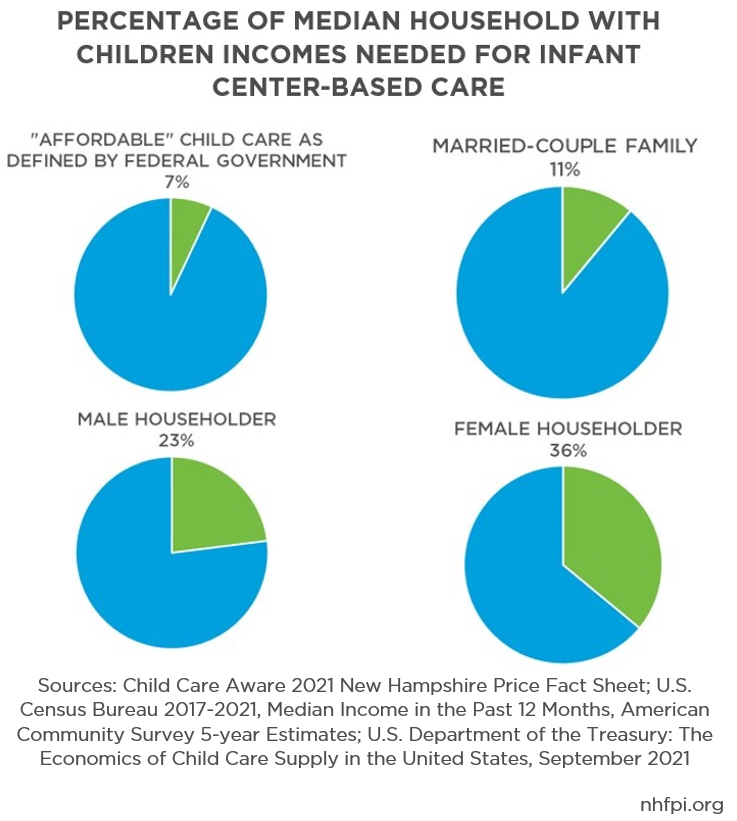Download a PDF version of this Fact Sheet here.
Child Care is Unaffordable for Most Granite State Families
- In 2022, the average annual price for an infant in center-based child care in New Hampshire was $15,340, and $10,140 annually for family child care. The average annual price for both an infant and a four-year old in center-based care was $28,340.
- For the 2017-2021 period, median income single male householders would have needed to spend 23 percent of their household incomes for an infant in center-based care, while median income single female householders would have needed to spend 36 percent.
Demand for Child Care Exceeds Available Spots
- On average between 2017 and 2021, an estimated 54,000 New Hampshire children under 6 years old (73 percent) lived in families that may have required child care, as both parents, or the sole parent of the household, were in the labor force.
- There were 756 licensed child care providers in New Hampshire in 2021, with a total capacity of 45,660 child care spots, suggesting a shortage of approximately 8,300 child care spots statewide.
- In 2022, there were 717 licensed child care providers in New Hampshire, with a capacity to serve 44,515 children. However, fewer child care spots may have been available in practice due to a reported staffing vacancy rate of 26 percent.
Workforce, Economic, and Societal Impacts
- Between October 5, 2022 and October 2, 2023, an average of 16,500 Granite Staters each month were not working because they were caring for children who were not in school or daycare.
- One national 2021 analysis estimated that New Hampshire households collectively lost between $400 million and $600 million in wages due to unavailable child care. Incorporating business and tax revenues, an estimated $44,110 and $66,816 per unavailable child care slot was lost annually over a ten-year time horizon from the time of the initial single-year child care shortage.
- Key research suggests a return of $4.20 for every $1 invested in state and district pre-Kindergarten programs for families with low incomes. Children who participate in these programs are more likely to finish high school, as well as have higher wages and lower health care costs later in life. These children are also less likely to need public assistance or engage in criminal activity in their lifetimes.
- The median hourly wage for a New Hampshire child care worker was $12.99. The median hourly wage for child care workers nationally was $13.17, while the median hourly wage for all New Hampshire workers was $23.04.
State Budget Investments and Policies Addressing Child Care Shortage
- The family income eligibility cap for child care assistance scholarships was raised to 85 percent of the State Median Income, increasing the income eligibility from $50,666 for a family of three in 2022 to $86,226. The prior eligibility threshold was 220 percent of the federal poverty guidelines.
- Cost sharing was eliminated for families below 100 percent of the federal poverty guidelines and limited to $5 per week for families under 138 percent of the federal poverty guidelines.
- Provider reimbursement for scholarship recipients was raised to 75th percentile of the market rate.
- $15 million was allocated for recruitment and retention of the child care workforce.
Download a PDF of the Fact Sheet Child Care in New Hampshire: High Price, Low Supply with citations, published at the New Hampshire Fiscal Policy Institute’s 8th Annual Conference, by clicking here.


